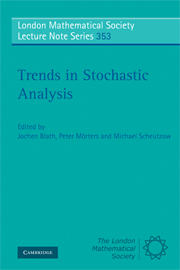Book contents
- Frontmatter
- Contents
- Preface
- Heinrich von Weizsäcker's students
- Heinrich von Weizsäcker's publications
- I Foundations and techniques in stochastic analysis
- 1 Random variables – without basic space
- 2 Chaining techniques and their application to stochastic flows
- 3 Ergodic properties of a class of non-Markovian processes
- 4 Why study multifractal spectra?
- II Construction, simulation, discretization of stochastic processes
- III Stochastic analysis in mathematical physics
- IV Stochastic analysis in mathematical biology
3 - Ergodic properties of a class of non-Markovian processes
Published online by Cambridge University Press: 05 March 2012
- Frontmatter
- Contents
- Preface
- Heinrich von Weizsäcker's students
- Heinrich von Weizsäcker's publications
- I Foundations and techniques in stochastic analysis
- 1 Random variables – without basic space
- 2 Chaining techniques and their application to stochastic flows
- 3 Ergodic properties of a class of non-Markovian processes
- 4 Why study multifractal spectra?
- II Construction, simulation, discretization of stochastic processes
- III Stochastic analysis in mathematical physics
- IV Stochastic analysis in mathematical biology
Summary
Abstract
We study a fairly general class of time-homogeneous stochastic evolutions driven by noises that are not white in time. As a consequence, the resulting processes do not have the Markov property. In this setting, we obtain constructive criteria for the uniqueness of stationary solutions that are very close in spirit to the existing criteria for Markov processes.
In the case of discrete time, where the driving noise consists of a stationary sequence of Gaussian random variables, we give optimal conditions on the spectral measure for our criteria to be applicable. In particular, we show that, under a certain assumption on the spectral density, our assumptions can be checked in virtually the same way as one would check that the Markov process obtained by replacing the driving sequence by a sequence of independent identically distributed Gaussian random variables is strong Feller and topologically irreducible. The results of the present paper are based on those obtained previously in the continuous time context of diffusions driven by fractional Brownian motion.
Introduction
Stochastic processes have been used as a powerful modelling tool for decades in situations where the evolution of a system has some random component, be it intrinsic or to model the interaction with a complex environment. In its most general form, a stochastic process describes the evolution X(t, ω) of a system, where t denotes the time parameter and ω takes values in some probability space and abstracts the ‘element of chance’ describing the randomness of the process.
Information
- Type
- Chapter
- Information
- Trends in Stochastic Analysis , pp. 65 - 98Publisher: Cambridge University PressPrint publication year: 2009
Accessibility standard: Unknown
Why this information is here
This section outlines the accessibility features of this content - including support for screen readers, full keyboard navigation and high-contrast display options. This may not be relevant for you.Accessibility Information
- 11
- Cited by
